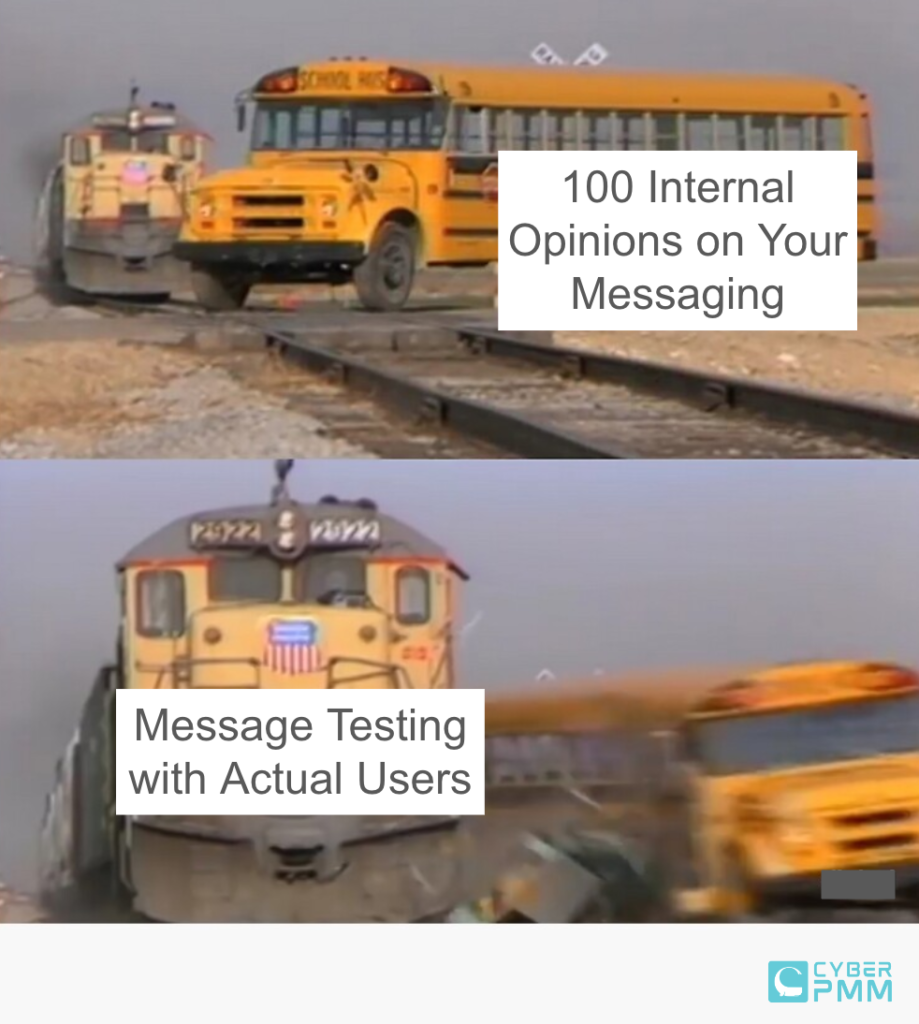Introduction
The key to developing great messaging is testing it out with others. This requires patience and humility. No, you don’t know it all! You have to work the process of testing with internal reviewers, with market analysts and most especially with users. Developing solid messaging will require many rounds of feedback with specific milestones/gates.
And just when you think you’re done, you’re going to receive eye-opening input that requires an update to your Product Messaging Brief (PMB). While the most important feedback you’ll receive is with users, the internal and analyst feedback rounds gets your message ready for that testing phase. Let’s start with a tried and tested process that I’ve used successfully.

The Cyber PMM 10 Step Message Testing Process
- Create a Development Plan & Rally Support
Create a development plan first before getting lost in a maze of feedback. This can be a simple list/sheet with columns for milestones, dates and feedback groups. Then communicate your plan with each group and ask them for help. - Create a Product Messaging Brief (v1)
Using a template as described on cyberpmm.com, create a PMB draft which is your first attempt at defining a message. This will be messy, and you won’t achieve perfection here, but you have to start somewhere to begin testing and getting feedback early. - Share v1 with Internal Feedback Groups
Armed with a PMB you will now share it with your closest internal feedback groups, mainly other PMMs, product managers, and others that have customer and product proximity. You will want to be specific about feedback you’re looking for and be clear that you don’t need grammatical input in the early phase. Add due dates to your requests to keep the ball rolling. Incorporate comments ASAP, especially the easy ones. - Schedule Analyst Briefings
You probably should have started scheduling analyst briefings earlier in the process because it can take a few weeks to get on analyst calendars. If you’re fortunate to have an analyst relations team with analyst relationships that can schedule these for you, get that conversation started ASAP. Many vendors will have contracts with these firms that allow for access to analysts to do things like message testing and it’s expected. However most PMMs/vendors don’t use this free service, don’t be that PMM! - Incorporate Analyst Feedback
Provide v2 of the PMB with the analyst before the briefing. Get to the point – don’t bore them by reading the entire brief on the call. No slides. Cover the key challenges you’ve discovered in your research. Then move to the value pillars, then be prepared with specific questions and don’t take their feedback personally if it’s critical. Incorporate input early. If you get a difficult analyst that dislikes “marketing” just keep repeating, “that’s great feedback, thanks.” And move on. - Prepare for User Tests
Armed with a PMB that has passed internal and analyst criticism, you can create a v3 and begin preparing for the most important step – user message tests. Create some graphics that showcase your 10 word description, value pillar headings, and value pillar overviews in the form of a landing page or other visual that groups of users can comment on. You won’t share the entire PMB with users. - Test Your Message with Users
This is by far the most important step. If I had a deadline to build a message in 5 days, I would skip internal and analyst reviews, spend one day building a message, then the next 4 asking users for input. A solid tool for message testing is Wynter. If you can’t use software, then share with users you are in contact with directly. If you are not in touch with users, you can check with your field/customer-facing teams for support. A solid sample size would be 25-50 users per persona group, but even 1 user’s input is better than nothing! - Create a Final Draft for Sign-Off
You now have passed internal, analyst and user testing gates. Congrats! It’s time to finalize and publish. Before you do so, share the final version with all reviewers as a courtesy with a last call for input. Also critical, get any necessary executive sign offs before publishing externally. The last thing you want is to have an executive derail the whole project at the 11th hour. If you are dependent on creative or web teams, start those tickets and processes ASAP. - Publish Internally with Broad Comms
It’s time to get the final message in the hands of your internal groups. While messaging is always living and never really “done”, you have to put a line in the sand and publish a final draft internally. Post a simple announcement (on Slack or wherever) with links to arm your peers and enable campaign/sales motions. - Publish Externally
Now for the fun part. It’s time to see your product’s web page refreshed with your new messaging. If you are able to track conversion metrics, it’s useful to measure performance before and after your page is updated to measure messaging value.
Tips for Internal Message Testing
The internal process is more about sharing a draft document around with key stakeholders. It’s an iterative process. In my experience, it’s best to get this done ASAP.

Give others a say
As you collect comments, update your messaging and ensure everyone that cares about the success of your product has their voice heard. Also, asking for help often yields good results later. I’ve had very smart people that were eager to dive in and edit my PMB. These edits were critical to getting it into a state where it was ready for the next phase, which is testing with industry analysts.
Ask for help
Leverage the smart people around you that care about your product. It’s not about you – it’s about building great messaging. And you don’t know it all, ask for help.
Use due dates
That said, set a firm due date on when you need input by. You should give them between 2-3 weeks to review to be respectful. Whatever you do, don’t ask for edits “by end of week” or even worse, “by end of day”. That’s just not going to work. Be firm in your due date and express the reason why and share your timeline. Be open about your development plans and why their input is important.
Specify feedback needed
Finally I recommend being specific about what type of input you need from which groups. For example if you know a technical SME that has domain expertise in a key feature, ask him or her to focus on that part. You don’t want time-constrained SME’s giving you grammar suggestions. That’s just not the time in the process for grammar anyway. That comes later, when you’re done with testing.
Focus feedback on substance over style
It’s very frustrating and you will experience this, but many reviewers focus way too much on grammar early in the process, and they don’t ask the strategic level questions you need early on. So just clearly state, “please do not comment on grammar.” Or, “Please focus on whether or not you think the challenges resonate based on your recent customer interactions.” Or, “Please focus on the value pillars and let me know if I’m missing any key elements.”
Tips for Message Testing with Industry Analysts
When it comes to testing a message with a market analyst, you have to be prepared for criticism in front of your peers by an objective voice. It’s one thing to manage feedback from people “in the tent” but when you start getting critical input from an actual market expert, it’s totally different.

Buckle up, buttercup
Remember, these analysts don’t pull punches and they meet with loads of vendors and customers on a daily basis. In these scenarios you will either toughen up your skin and take the feedback, appreciate it and learn, or you’ll do the worst thing possible – get defensive.
Actually use the input
I implore you to go through the market analyst testing phase but you should be ready to actually take their input seriously. Going into those sessions thinking that your message is perfect is just not wise.
Don’t drink your own kool-aid
First of all, these analysts don’t owe you any favors. Yes, your company pays them sometimes for report licenses, but they are doing that with every other vendor in the industry. If someone’s input never mattered in the first place, you are likely drinking your own kool-aid and need a reality check.
Don’t try to impress
I’ve seen scenarios where PMMs think, “I’m going to impress my peers and this analyst with my amazing message.” Then they get shattered when an analyst says, “yeah, seen it before, you’re not differentiated, that message doesn’t resonate with the client inquiries I see at all.” Ouch. Reality check.
Stay open-minded
It’s best to enter the market analyst discussion with an open mind, and don’t over invest in developing a final message prior to the testing. The entire point of testing the message is to see if it works. You have to be 100% prepared for any outcome. It’s not bad if the analyst doesn’t like the message, it’s actually a good thing because you still have time to adjust.
Tips for Message Testing with Users
Message testing with users is the most critical part of the process. Get this right, and you will not go wrong with messaging.

Use software like Wynter
I highly recommend using a tool like Wynter for message testing with users. It’s worth the investment. However, I realize that not everyone can just jump into new software or has budget available.
Keep it simple stupid
Keep your user tests very simple. Distill your core value proposition and differentiation into a single slide or visual. Then you can put it in front of a user(s) and ask, “Does this resonate with you, yes or no?” Then follow up with, “Please elaborate in 15 words or more”. These two questions are really all you need. You can do this with Wynter or create your own form or test using other means. This way you can compare variations and say, “45% found version A to resonate, while 64% found version B to resonate more.”
Test with multiple personas
I also recommend spreading out your tests with different persona groups. I once did a message test with 30 CISOs, 30 SOC Directors and 30 Security Analysts. The results were significantly different across the three groups, which created a lot of insight in my approach to each group.
Use data vs. the loudest voice in the room
The best part of getting testing results is now you have data to make messaging decisions instead of just getting bullied by the loudest voice in the room. Trust me, for any PMM doing message testing, there will always be someone shouting the loudest with their opinion on what a great message looks like. You need to rest on message testing instead of one person’s opinion. Everyone has an opinion. But collecting user opinions in larger amounts allows you to be more objective in decision making.
Conclusion
Messaging isn’t easy. Opinions are in abundance, yet aren’t actionable when it comes to the science of messaging. User data is your best friend. Do your best to get user feedback in bulk to make objective decisions about your messaging. And enter that user conversation having built a solid foundation. That foundation is built on a concrete mixture of your knowledge, internal feedback, and analyst feedback. Ask for help in the process and be flexible on the message during development phases, but firm on the process to finalize and publish a tried and tested message.
Stay tuned for future posts by subscribing to the newsletter on Substack or directly on the Cyber PMM website. You can also follow Cyber PMM or me on LinkedIn.


